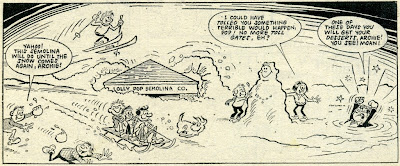The Fixer was an unsophisticated strip about a little boy who was always there to fix things for other people in exchange for a bag of sweets, or sometimes simply for the sport of it. Fixer’s cunning plots usually worked fine at first but then backfired leaving him in trouble and without sweets. The first episode and three later ones in issues 6, 7 and 9 were by Peter Davidson. Here’s a panel from issue 6, complete with the artist’s trademark pet in the foreground:
The Fixer started in the first issue of SHIVER AND SHAKE. The b/w strip was part of SHAKE section and continued until issue 52, missing six weeks during its run (it was not included in issues 16, 20, 27, 30, 35, 44).


























